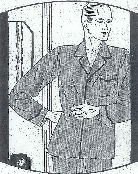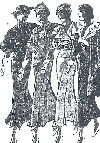Fashions and Accessories Men's, ladies and childrens fashions in the 1930's
What People Wore Back in 1930
Less and less people were sewing in the 1930s. This was the beginning of the ready-to-wear fashion age. However, times were hard and things were scarce during this decade as well.
Since the 1930s was the decade of recovering from the 1929 Great Depression and stock market crash, companies started researching and implementing cheaper means of clothing manufacturing. New materials that were cheaper to process had been created during this decade to replace more expensive materials.
For example, rayon for women’s hose had been replaced by nylon during this decade. Likewise, many of the dresses that used to be made out of silk were made out of different grades of rayon. The zipper became more widely used and replaced buttons during this decade as well (see towards end of article).
Women’s Fashion in the 1930s
Less and less people were sewing in the 1930s. This was the beginning of the ready-to-wear fashion age. However, times were hard and things were scarce during this decade as well.
Since the 1930s was the decade of recovering from the 1929 Great Depression and stock market crash, companies started researching and implementing cheaper means of clothing manufacturing. New materials that were cheaper to process had been created during this decade to replace more expensive materials.
For example, rayon for women’s hose had been replaced by nylon during this decade. Likewise, many of the dresses that used to be made out of silk were made out of different grades of rayon. The zipper became more widely used and replaced buttons during this decade as well (see towards end of article).
Clothing styles were less extravagant for the most part during the 1930s. However, you could still tell between the “haves” and “have nots” of this time. Some of the more affluent type of dress was presented by models in issues of the women’s magazine Good Housekeeping.
You can see some of the businesslike influence in these simple outfits if you go back to the April 1930 issue. Models in some of the photos displayed simple-yet feminine outfits of two-piece V-neck cardigan, simple blouse, and button-down wrap skirts.
Other photos presented in this issue of Good Housekeeping showed off long free-flowing dresses with moderately low V-necklines. These dresses are known often as the “1930s Trousseau”.
These particular outfits are what many people would perhaps associate in times past with tea time or luncheon in high society. These particular elegant yet simple lines of clothing or in the ever-growing middle class social circle.
The shapes of these dresses were designed to show off a woman’s most feminine features-tight or snug at the waist and then bowing slightly out. Most of these dresses are either slightly gathered and/or pleated. The pattern for many of the early 1930s dresses that were made is known as the “cross cut bias” style.
Some of them are one-piece while others are accented with a short elegant jacket. Today (the year 2007) many people would consider wearing these styles of dresses to a formal or semi-formal dinner.
All though women did cut back on the number and style of clothes, Ladies Hats were still an integral part of any Ladies wardrobe
Ladies Newport Matinee hat $1.59The sleeves of most of the 1930s dresses and outfits referenced in this article are of ¾ length or shorter. The Hem line of most of the outfits during this time was cut between the knees and the shin. Colors of fashionable ladie’s wear in the 1930s were of different colors such as red, navy, white, and black.
One of the most famous fashion influences of the 1930s was Coco Chanel. Another one of this time was Madeleine Vionnet, who was a French Designer.
In fact, Vionnet was the one who is most known for the “cross cut bias” pattern for dresses, which is a style associated with actress or dancers such as Ginger Rogers. This particular type of dress is very long, and is usually all the way down to the lower back.
In a 1932 drawing of the back view of a lady wearing a bias cut dress, a bow accents the backside just below the V-shaped back opening. This particular look is one of the elegant and wealthy, and is likely to cost more than the simpler fashions described earlier in this article.
Silk Pajamas

Luxurious Pure Dye Silk Pajamas
Price: $2.98
Ladies Dresses

The Latest Fashion Ladies Dresses
Price: $4.98
Men’s Fashion in the 1930s
Edward the III was a major figure during these times for unusual male fashion. He is seen in short, baggy knee pants known as “Plus Fours” along with a round-necked schoolboy sweater.
Underneath he was wearing a white butterfly-collared shirt with a black tie. On his head he was wearing a “grandpa" style hat.
Both men and boys wore full three-pieced suits during this time when attending formal occasions such as weddings. Similar to in present day, these were made with broader shoulders and a more masculine-looking pattern than in earlier years.
The alternative was usually something along the line of a sweater vest and knickers or trousers. These were also popular in the 1920s as well.
Hats, Accessories, and Beachwear
Swimwear for the ladies during this decade was fairly modest, but perhaps a little more revealing in contrast to other times in history. A basic swimsuit made during these times look much like the one-piece short tank outfits that are popular today.
A similar style of swimsuit during this time is the one that is made with an overskirt to help hide a bulging stomach and larger sized thighs. Some of the suits made in this era were two-pieced as well, and often accented with a wide beach hat or a bow around the waist.
Backs on women’s swimsuits were low during this decade. Suits were made from colors such as ivory, white, cream, grey, black, and buff. Sometimes they were accented with touches of red.
Hats during this time for women were either wide-brimmed, crowned, or of a sailor style. Smaller pert hats were also created during this period of time
Also, between 1935 and 1939 the use of what is called a crochet “snood” and scarves were used. Most women used them to hold the back of the hair up.
The hats that men wore during this decade include this decade include a variety of different berets and top hats. One of the most famous male hat styles of these years is the “fedora” which is a hat made of a soft material (i.e. felt), dented lengthwise, and has a tapered rim. In later years (1940s) Humphrey Bogart wore a fedora in Casablanca.
The Invention of the Zipper
What we know today as the zipper made more popular by a designer named Schiaparelli in the year 1933. It is not as sophisticated of a brand of zipper as what people know of and use today, but it became more universal than in times past.
Some examples of Fashion Prices in the 1930's taken from newspaper Adds
Men's Shirt $2.50 Ohio 1932
Ladies Wool Flannel Robes $3.95 Nebraska 1934
Ladies Winter Coats $16.00 Indiana 1937
Men's Quality Overcoats $15.00 Indiana 1937
Ladies Oxfords Shoes $2.44 Indiana 1937
Men's Slacks $3.98 Indiana 1937
Women's silk hose 49 cents Ohio 1933
Boys overcoat wool 8.69-11.98/each From $ New Jersey
Boys pants and breeches, corderoy From $1.98 New Jersey
Boys school suit, From $7.94 New Jersey
Girls hose (tights), woolen, From $25 cents per pair New Jersey
Men s shirt, Arrow, From $1.45 New Jersey
Men s sport coat, /each From $19.98 New Jersey
Women s dress shoes, From $3.45 New Jersey
Women s suit, 2 pieces, From $6.98 New Jersey
Men's Sox 10 cents ohio 1933
Ladies Sandals 98 cents Maryland 1939
Boys and Girls Underwear 49 cents Maryland 1935
Men's 2 Piece Suit Double breasted $19.75 New York 1935
Howard Deluxe Quality silk lined hat $2.85 New York 1935
Sheeplined Moccasins 79 cents Ohio 1935
Fancy Broadcloth Pajamas $1.89 Indiana 1937
Men's Lined Gloves 98 cents ohio 1935